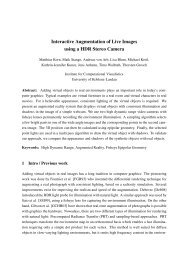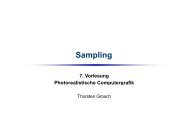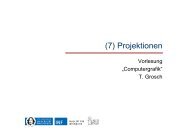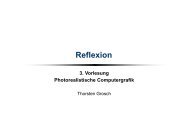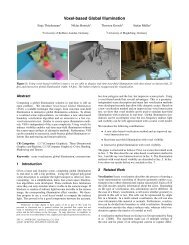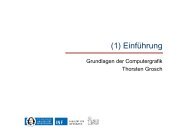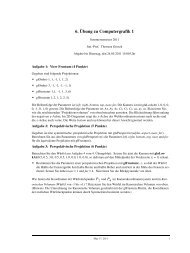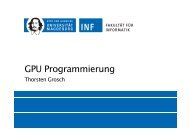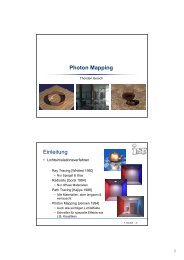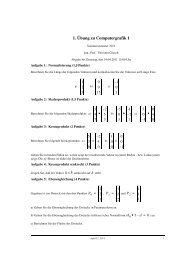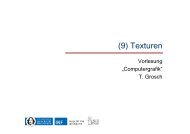Interactive Global Illumination Based on Coherent Surface Shadow ...
Interactive Global Illumination Based on Coherent Surface Shadow ...
Interactive Global Illumination Based on Coherent Surface Shadow ...
You also want an ePaper? Increase the reach of your titles
YUMPU automatically turns print PDFs into web optimized ePapers that Google loves.
until a leaf is reached; then use the skip-pointer and c<strong>on</strong>tinue. Moreover,<br />
this enables a selective traversal (required for refinement), as<br />
described in the next subsecti<strong>on</strong>.<br />
For each node, all data is stored in 128 bits using a single 32-bit<br />
RGBA integer texel. 24 bits are used for: Center positi<strong>on</strong>, average<br />
normal and radiant intensity, 8 bits for: radius, normal c<strong>on</strong>e angle<br />
and area, and 16 bits for both pointers. Due to the size limitati<strong>on</strong>s of<br />
<strong>on</strong>e-dimensi<strong>on</strong>al textures, the hierarchy is stored in a native layout<br />
as a two-dimensi<strong>on</strong>al texture. Both pointers are c<strong>on</strong>verted into this<br />
layout when storing the hierarchy. One example is shown in the left<br />
of Fig. 11.<br />
4.3 Hierarchy Traversal<br />
The data structure introduced in the previous secti<strong>on</strong> enables a combined<br />
implementati<strong>on</strong> of Refine and Gather for a receiver leaf node<br />
N r : Starting from the root, the tree is traversed in depth-first order<br />
by following the child-pointer as l<strong>on</strong>g as an oracle functi<strong>on</strong> decides<br />
to refine the current sender node N s . In case of no refinement, N s<br />
is an appropriate sender level and the radiance transmissi<strong>on</strong> from<br />
N s to N r is computed and accumulated. To accomplish this, a form<br />
factor and a CSSM-based visibility value are computed here. Now,<br />
all nodes below N s can be ignored by following the skip-pointer,<br />
and the process can be repeated. The pseudo-code for this traversal<br />
is shown in Fig. 10.<br />
We use an energy-based refinement oracle which computes an upper<br />
bound of the received radiance L max from N s to N r . The same upper<br />
bound computati<strong>on</strong> as presented in [24] is used here. Now, N s is<br />
refined if the t<strong>on</strong>e-mapped value of L max is above a user-defined<br />
threshold. In this way, the refinement adapts to the current display<br />
settings (we use a simple gamma t<strong>on</strong>e mapper in our examples).<br />
senderNode = root<br />
L = 0<br />
while(senderNode != NULL) {<br />
if oracle(senderNode, receiverNode, threshold) {<br />
senderNode = senderNode.leftChild // Refine<br />
}<br />
else {<br />
L += computeRadiance(senderNode, receiverNode)<br />
senderNode = senderNode.skip // Gather<br />
}<br />
}<br />
Figure 10: Pseudocode for stack-less GPU tree traversal. This<br />
combines the Refine and Gather step for an arbitrary receiver leaf<br />
node. No links need to be stored in this way.<br />
4.4 Final Gathering<br />
The direct visualizati<strong>on</strong> of a radiosity soluti<strong>on</strong> suffers from discretizati<strong>on</strong><br />
artifacts, like jagged shadows. Better, but slower results<br />
are obtained when using final gathering for display. Recently, Walter<br />
et al. [24] introduced lightcuts, a fast final gathering method. Their<br />
original algorithm assumes a c<strong>on</strong>verged lighting simulati<strong>on</strong> from<br />
which a hierarchy of VPLs is created. To select the minimal number<br />
of VPLs for a given receiver point, an initial cut through the hierarchy<br />
is computed (usually just the root node). Then the node inside<br />
the cut with the largest error relative to the total incident radiance<br />
is selected. If this relative error is perceivable for the human eye<br />
(this means larger than two percent due to Weber’s law) the node is<br />
removed and its children are placed into the cut. This is repeated<br />
until the node with the largest c<strong>on</strong>tributi<strong>on</strong> is below two percent or a<br />
maximum number of nodes is reached.<br />
Figure 11: The glossy Cornell Box and the corresp<strong>on</strong>ding VPL tree<br />
which stores direct light in a texture (left). The indirect light is<br />
computed by final gathering. The cut size (number of nodes in the<br />
cut) for gathering indirect light is visualized <strong>on</strong> the right.<br />
4.4.1 Final Gathering <strong>on</strong> the GPU<br />
We found the original lightcuts algorithm unsuitable for a GPU<br />
implementati<strong>on</strong> for two reas<strong>on</strong>s. First, it requires a priority queue to<br />
quickly identify the node with the largest error, which is difficult to<br />
maintain efficiently <strong>on</strong> a GPU. Sec<strong>on</strong>dly, the original error bound is<br />
quite expensive to compute.<br />
Instead, we propose to c<strong>on</strong>struct a simplified cut for an arbitrary<br />
receiver point: After computing multiple diffuse bounces, all nodes<br />
in the hierarchy are VPLs which c<strong>on</strong>tain direct and indirect light.<br />
Therefore, the same algorithm as shown in Fig. 10 can be used to<br />
compute the cut and gather from all nodes in the cut. The <strong>on</strong>ly<br />
difference is, that the receiver node has to be replaced by the receiver<br />
positi<strong>on</strong> of the current framebuffer pixel. Because the final bounce<br />
allows glossy surfaces, the oracle functi<strong>on</strong> now includes the computati<strong>on</strong><br />
of an upper bound of the Ph<strong>on</strong>g BRDF [24] for computing<br />
L max . This approach poses no c<strong>on</strong>straints <strong>on</strong> the final receiver pixel<br />
at all. We are free to use normal maps, high frequency textures and<br />
arbitrary BRDFs. Fig. 11 (right) shows a visualizati<strong>on</strong> of the cut<br />
size we achieve: For large regi<strong>on</strong>s in the image, a low number of<br />
VPLs is sufficient for a good quality. A direct visualizati<strong>on</strong> of the<br />
illuminated atlas is possible, but better visual results are obtained<br />
with final gathering, as shown in Fig 17.<br />
In comparis<strong>on</strong> with the original lightcuts alorithm, we use an energybased<br />
oracle instead of a perceptually-based criteri<strong>on</strong>. N<strong>on</strong>etheless,<br />
we found that for a GPU implementati<strong>on</strong>, the benefits of the simplificati<strong>on</strong>s<br />
outweigh the algorithmic deficiencies. Recently, Akerlund<br />
et al. also used cuts [1] for global illuminati<strong>on</strong>. However, they precompute<br />
the entire cut for static vertices, whereas we find the cuts<br />
dynamically for each pixel.<br />
4.5 Jittering<br />
One problem of VPL-based global illuminati<strong>on</strong> is the limitati<strong>on</strong> to<br />
moderately glossy BRDFs. When glossiness is increased, single<br />
highlights become apparent where a c<strong>on</strong>tinuous highlight should<br />
appear. We mitigate these artifacts in our approach by associating<br />
an approximate area with every VPL from which we pick a random<br />
locati<strong>on</strong> instead of the VPL’s center locati<strong>on</strong>. When several frames<br />
with different random locati<strong>on</strong> samples are averaged this ’VPL bias’<br />
can be removed as can be seen in Fig. 12.



